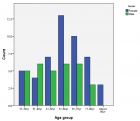Abstract
Editorial
Endogenous Ligands of Toll Like Receptors: A Danger Signal to the Brain Memory at High Altitude
KP Mishra* and Shashi Bala Singh
Published: 15 October, 2018 | Volume 2 - Issue 1 | Pages: 026-027
Sojourn to high altitude may affect various human systems if proper acclimatization not followed. If acclimatization failed, sojourners may suffer with high altitude sickness such as acute mountain sickness (AMS), high altitude pulmonary edema (HAPE) and high altitude cerebral edema (HACE). Although a sojourner’s tolerance to high altitude hypoxia varies according to differences in physiology and physical conditioning. Acute mountain sickness may cause headache, insomnia, dizziness, nausea, vomiting and fatigue. While HACE is more serious stage where brain swelling occurs and it is potentially fatal. A sojourner with HACE may experience confusion, amnesia, delusions, and loss of consciousness. Staying in high altitude (above 9000 feet) environment poses low oxygen supply (hypobaric hypoxia) to the different body organs including brain.
Read Full Article HTML DOI: 10.29328/journal.icci.1001005 Cite this Article Read Full Article PDF
References
- Das S, Mishra KP, Ganju L, Singh SB. Andrographolide - A promising therapeutic agent, negatively regulates glial cell derived neurodegeneration of prefrontal cortex, hippocampus and working memory impairment. J Neuroimmunol. 2017; 313: 161-175. Ref.: https://goo.gl/yqePWR
- Das S, Mishra KP, Ganju L, Singh SB. Intranasally delivered small interfering RNA-mediated suppression of scavenger receptor Mac-1 attenuates microglial phenotype switching and working memory impairment following hypoxia. Neuropharmacology. 2018; 137: 240-255. Ref.: https://goo.gl/mvJsFp
- Khanna K, Mishra KP, Ganju L, Kumar B, Singh SB. High-Altitude-Induced alterations in Gut-Immune Axis: A review. Int Rev Immunol. 2018; 37: 119-126. Ref.: https://goo.gl/2rFgaj
- Kumar R, Jain V, Kushwah N, Dheer A, Mishra KP, et al. Role of DNA Methylation in Hypobaric Hypoxia-Induced Neurodegeneration and Spatial Memory Impairment. Ann Neurosci 2018; 25: 191–200. Ref.: https://goo.gl/v9MYdr
- Mishra KP, Ganju L, Singh SB. Hypoxia modulates innate immune factors: A review. Int Immunopharmacol. 2015; 28: 425-428. https://goo.gl/Z2cC38
- Mishra KP, Sharma N, Soree P, Gupta RK, Ganju L, Singh SB. Hypoxia-Induced Inflammatory Chemokines in Subjects with a History of High-Altitude Pulmonary Edema. Indian J Clin Biochem. 2016; 31: 81-86. Ref.: https://goo.gl/A2zWC7
- Shweta, Mishra KP, Chanda S, Singh SB, Ganju L. A comparative immunological analysis of CoCl2 treated cells with in vitro hypoxic exposure. Biometals. 2015; 28: 175-185. Ref.: https://goo.gl/x9sMwC
Similar Articles
-
Dendritic cells and TNF-Related apoptosis inducing ligand (TRAIL) represent new possibilities for sepsis treatmentPetya Ganova,Lyudmila Belenska-Todorova,Nina Ivanovska*. Dendritic cells and TNF-Related apoptosis inducing ligand (TRAIL) represent new possibilities for sepsis treatment. . 2017 doi: 10.29328/journal.hcci.1001001; 1: 001-004
-
Brain response in some systemic immune condition-Toxicological aspectsLuisetto M*. Brain response in some systemic immune condition-Toxicological aspects. . 2017 doi: 10.29328/journal.icci.1001002; 1: 005-008
-
The Immunitary role in chronic prostatitis and growth factors as promoter of BPHMauro luisetto*,Behzad Nili-Ahmadabadi,Ghulam Rasool Mashori,Ram Kumar Sahu,Farhan Ahmad Khan,Cabianca luca,Heba Nasser. The Immunitary role in chronic prostatitis and growth factors as promoter of BPH. . 2018 doi: 10.29328/journal.icci.1001003; 2: 001-013
-
Expression of C-type Natriuretic Peptide and its Specific Guanylyl Cyclase-Coupled Receptor in Pig Ovarian Granulosa CellsSoo Mi Kim,Suhn Hee Kim,Kyung Woo Cho,Sun Young Kim,Sung Zoo Kim*. Expression of C-type Natriuretic Peptide and its Specific Guanylyl Cyclase-Coupled Receptor in Pig Ovarian Granulosa Cells. . 2018 doi: 10.29328/journal.icci.1001004; 2: 014-025
-
Endogenous Ligands of Toll Like Receptors: A Danger Signal to the Brain Memory at High AltitudeKP Mishra*,Shashi Bala Singh. Endogenous Ligands of Toll Like Receptors: A Danger Signal to the Brain Memory at High Altitude. . 2018 doi: 10.29328/journal.icci.1001005; 2: 026-027
-
Differentiation of bone marrow cells in arthritic mice with decreased complement activityPetya Ganova,Nina Ivanovska*. Differentiation of bone marrow cells in arthritic mice with decreased complement activity. . 2018 doi: 10.29328/journal.icci.1001006; 2: 028-038
-
Effect of common food additives on mast cell activationCarena MP,Mariani ML,Ordóñez A,Penissi AB*. Effect of common food additives on mast cell activation. . 2019 doi: 10.29328/journal.icci.1001007; 3: 001-005
-
Association of Toll-like receptor 2, 4, and 9 gene polymorphism with high altitude induced thrombosis patients in Indian populationSwati Sharma,Iti Garg*,Gauri Mishra,Babita Kumari,Lilly Ganju,Bhuvnesh Kumar. Association of Toll-like receptor 2, 4, and 9 gene polymorphism with high altitude induced thrombosis patients in Indian population. . 2019 doi: 10.29328/journal.icci.1001008; 3: 006-015
-
Altitude sickness and Antarctic polar plateau: A reviewKP Mishra*,Shashi Bala Singh. Altitude sickness and Antarctic polar plateau: A review. . 2019 doi: 10.29328/journal.icci.1001009; 3: 016-018
-
Proposal for the elimination of allergiesJames F Walles*. Proposal for the elimination of allergies. . 2019 doi: 10.29328/journal.icci.1001010; 3: 019-019
Recently Viewed
-
Relationship between Vitamin D Deficiency and Lipopolysaccharides Porphyromonas gingivalis Bacteria in Stunting ChildrenErwin Gunawan*,Ria Puspitawati. Relationship between Vitamin D Deficiency and Lipopolysaccharides Porphyromonas gingivalis Bacteria in Stunting Children. Ann Biomed Sci Eng. 2024: doi: 10.29328/journal.abse.1001033; 8: 059-065
-
Addiction to self-strangulation: a case-reportAurely Ameller*,Yann Le Strat,Marion Cadranel,Celine Portalier, Caroline Dubertret. Addiction to self-strangulation: a case-report . J Addict Ther Res. 2017: doi: 10.29328/journal.jatr.1001003; 1: 016-021
-
Nanoencapsulated Extracts from Leaves of Bauhinia forficata Link: In vitro Antioxidant, Toxicogenetic, and Hypoglycemic Activity Effects in Streptozotocin-induced Diabetic MiceBárbara Verônica Cardoso de Souza, Alessandra Braga Ribeiro*, Rita de Cássia Meneses Oliveira, Julianne Viana Freire Portela, Ana Amélia de Carvalho Melo Cavalcante, Esmeralda Maria Lustosa Barros, Luís Felipe Lima Matos, Tarsia Giabardo Alves, Maria. Nanoencapsulated Extracts from Leaves of Bauhinia forficata Link: In vitro Antioxidant, Toxicogenetic, and Hypoglycemic Activity Effects in Streptozotocin-induced Diabetic Mice. Arch Pharm Pharma Sci. 2024: doi: 10.29328/journal.apps.1001063; 8: 100-115
-
Oral Suspension as Versatile Galenic Formulation in PediatryMauro Luisetto*, Almukthar N, Edbey K, Mashori GR, Fiazza C, Dona’ l, Cabianca L, Latyshev O. Oral Suspension as Versatile Galenic Formulation in Pediatry. Arch Pharm Pharma Sci. 2024: doi: 10.29328/journal.apps.1001062; 8: 091-099
-
Modulation of Microbiota and its Impact on DepressionKousik Maparu*. Modulation of Microbiota and its Impact on Depression. Arch Pharm Pharma Sci. 2024: doi: 10.29328/journal.apps.1001061; 8: 089-090
Most Viewed
-
Evaluation of Biostimulants Based on Recovered Protein Hydrolysates from Animal By-products as Plant Growth EnhancersH Pérez-Aguilar*, M Lacruz-Asaro, F Arán-Ais. Evaluation of Biostimulants Based on Recovered Protein Hydrolysates from Animal By-products as Plant Growth Enhancers. J Plant Sci Phytopathol. 2023 doi: 10.29328/journal.jpsp.1001104; 7: 042-047
-
Sinonasal Myxoma Extending into the Orbit in a 4-Year Old: A Case PresentationJulian A Purrinos*, Ramzi Younis. Sinonasal Myxoma Extending into the Orbit in a 4-Year Old: A Case Presentation. Arch Case Rep. 2024 doi: 10.29328/journal.acr.1001099; 8: 075-077
-
Feasibility study of magnetic sensing for detecting single-neuron action potentialsDenis Tonini,Kai Wu,Renata Saha,Jian-Ping Wang*. Feasibility study of magnetic sensing for detecting single-neuron action potentials. Ann Biomed Sci Eng. 2022 doi: 10.29328/journal.abse.1001018; 6: 019-029
-
Pediatric Dysgerminoma: Unveiling a Rare Ovarian TumorFaten Limaiem*, Khalil Saffar, Ahmed Halouani. Pediatric Dysgerminoma: Unveiling a Rare Ovarian Tumor. Arch Case Rep. 2024 doi: 10.29328/journal.acr.1001087; 8: 010-013
-
Physical activity can change the physiological and psychological circumstances during COVID-19 pandemic: A narrative reviewKhashayar Maroufi*. Physical activity can change the physiological and psychological circumstances during COVID-19 pandemic: A narrative review. J Sports Med Ther. 2021 doi: 10.29328/journal.jsmt.1001051; 6: 001-007

HSPI: We're glad you're here. Please click "create a new Query" if you are a new visitor to our website and need further information from us.
If you are already a member of our network and need to keep track of any developments regarding a question you have already submitted, click "take me to my Query."
















































































































































